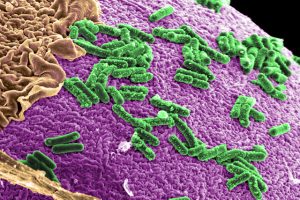Controlling and Reanimating the Brain
Neuroscientist Emery Brown on the anesthetic state, the arousal network, and medical coma
What are the biological causes of social behavior? How do different animals get signals that affect their interactions? What role does smell play in the lives of rodents and mammals? These and other questions are answered by Higgins Professor of Molecular and Cellular Biology, Catherine Dulac.
Humans are absolutely fascinated by social behavior, social interaction. We think about our own social interaction, it keeps us busy, it keeps us worried. Social interactions, love, fight, are also inspiring art, literature, poetry, change the world with war and all sort of more positive, romantic adventure that we love to read or hear about.
And so for scientists there is something very special about how we recognize each other, or, more generally, how animals recognize each other. And one essential question in biology or neuroscience is how animals recognise each other, why is the recognition of an individual within a species occurring? Are there specific dedicated brain areas that are specialized into recognizing other animals and, in particular, into recognizing an animal of the other sex in order to mate and to reproduce? Specific secret and neurons dedicated to recognize an animal of the same sex that could be a rival? But also how to recognize our offspring, children or infants, or pups in animals? All this recognition is absolutely essential.
The original question, the first question then to understand these behaviors is: what are the signals that elicit specific behaviors, how does an animal recognize – “oh, this is a female”, “this is a potential mating partner”, or “this is a male, I have to fight, because that’s a rival”? And Niko Tinbergen, for example, who was extraordinarily influential and still is, discovered that animals often recognize each other not by recognizing a set of very complex features, but by recognizing what he called “sign stimuli” which are extremely simple features that in essence symbolize an entire stage, or sex, or gender, or physiological status of an animal.
And one discovery led to very famous anecdotes: he had these stickleback fish in his lab, and he had mature males, and males developed a red belly (and that’s a sign of a sexually mature male), and he realized, to his surprise, that every day at the same hour of the day these male fish were all adopting an aggressive posture, which is the head to the bottom and exposing their red belly, every day, same time. And so he started to look what was happening at this time, and he discovered that every day at the same time in the road adjacent to his lab there was a truck of the mailman that was driving by, and that track had a red colour. And so it made him think that maybe these male fish identified this red truck as another male, and therefore all displayed this aggressive posture. So he tested this by showing to this fish a little decoy of a fish representing a fish quite exactly, and if that decoy was all very representative of the fish, but without any colour, it wouldn’t do a thing. But if he took a very simple decoy that was basically just an oval shaped decoy, but the bottom half was red – that was sufficient to elicit this very stereotyped aggressive posture. And so from these and a lot of other experiments he realized that all that the fish needed was to have this very simplistic representation of another male fish, and the sign stimulus of aggression was simply this oval shape with a red bottom.
There are many, many more examples of these: the way the seagulls recognize the newly hatched birds and start to feed them, because they get the specific signal. All throughout examples of it in fish, in insects, and in birds there is this very interesting recognition of simple signs.
Scientists working with mammals try to see what are the specific signals that trigger social behavior.
They tried to impair vision – it didn’t do anything to maternal recognition, for example, they tried to impair olfaction – it didn’t do anything, they tried to impair touch – it also didn’t do anything. But if you impair several of the sensory modalities – then now the moms could not recognize their offspring in the rats, for example, or in other mammalian species. From these came the really basic question of how do mammalian species, or animals in general recognize their offspring, or their mate, or their rival.
How do you analyse behavior? Well, you observe animals, and for a very long time the way to observe animals was to go to the field and observe animals in their natural habitat. But there are very big limitations for doing this, because many animals go underground, for example, and so a lot of interactions are not visible. And then, every person doing a field study will probably have different observations, because the system is not quite identical from one observation to the other.
So the big revolution really came in the development of genetics. And a very big name in the field, the pioneer in this study of the neurobiology of behavior was Seymour Benzer. Seymour Benzer was one of the pioneers in molecular biology. And he postulated, he hypothesised that one could also study behavior by using genetic methods. His model of study was Drosophila. And he simply tried to study mutants for specific genes and look at their impact on behavior. It was a huge bet, because many scientists at the time were saying: “oh, behavior is much too complicated to be reduced to the function of genes”. And I guess, he had this intuition of the genetic basis of behavior from looking at simpler organisms such as viruses or bacteria. If you affect a gene, if you mutate a gene and it affects the behavior of a bacterium, why it wouldn’t affect also the behavior of a Drosophila, for example, or other species.
And so from Drosophila then other scientists got inspired to look at mice, or rats, or other animal models. And Drosophila is still a fantastic model system to look at behavior, other invertebrate systems such C.elegans also, and there are extraordinary scientists right now working on these animal models.
In mammals the model of choice is the mouse. It’s a system in which one can abolish the function of specific genes using genetic recombination, or genetic engineering in general. And so the idea is to try to identify what are the key genes that affect specific behavior in the mouse, and we are particularly interested in social recognition, as I’ve mentioned. And in the mouse, or rodents in general, the way animals recognize other mice is through the sense of smell. And so the olfactory system is really essential for the animal to be able to recognize its surrounds, and to be able to recognize potential mates, rivals, kins, etc.
The field of olfaction really was entirely revolutionized by the discovery in 1991 of the olfactory receptor gene by Linda Burke and Richard Axel. So they discovered that a very large family of a thousand genes encodes a very diverse family of receptors that are specifically expressed in the nose, and each receptor is able to detect or recognize a very specific set of molecules, of odorants.
In rodents there is also another set of olfactory neurons specialized on detecting pheromones. When I was a postdoctoral fellow in Richard Axel’s lab and then, in my own laboratory, I discovered the receptors for pheromones, the receptors that are expressed by a set of neurons located in the part of the nose called the vomeronasal organ, or VMO for short. And so what we discovered is that the VMO receptors are completely unrelated to the odorant receptors.
So the idea is that there’s something very special about the molecules that convey social information.
Pheromones are by definition molecules that are released by animals to provide information about their sex, or their physiological status, or the genetic status.
And so, with the discovery of these VMO receptors, now we could address very specific questions about how are these social cues identified and what do they do to the brain. And we were able recently to pair specific receptor molecules to a specific source of information, and, to our surprise, we actually discovered that many of these receptors are involved in detecting predators.
So this set of neurons in the vomeronasal organ is not only essential to detect a female mouse, or a male mouse, or an infant mouse, but also a very large category of predators. Some receptors are specialized into detecting mammalian predators very specifically, some are specialized into detecting birds of prey, or reptile, some receptors are even more specialized to take the one particular mammalian predator, let’s say, fox, or a particular type of snake.And so our work now in the future is to try to understand how does the specific information for a particular predator or a particular type of mouse then relate to the brain, how does the brain make sense of these various signals.
So the neurobiology of behavior is, I think, interesting in many ways, but I think, there are two very compelling reasons. One is: the brain is here to organize behavior, that’s the function of this organ, it’s an extremely complex function, and we don’t know anything about it. And so the hope is to understand the signalling throughout the brain, how does the brain decipher signals from the outside, computes them and then comes up with behavior. This is what the brain does, and addressing these questions very specifically would give us insight on what is the biggest black box in our organsism – that’s the brain, we don’t really know how the brain works. And this is a way to directly approach that function.
The second very compelling reason is the fact that because in part we don’t understand the brain, we also don’t know how to diagnose mental illnesses and we don’t know how to cure or treat mental illnesses very well. If we understand some basic mechanisms of how behavior is generated, then we will hopefully be able to have better diagnosis for a disease like autism, or schizophrenia, or depression, where patients are really impaired in their social recognition and therefore in their overall behavior in society.

Neuroscientist Emery Brown on the anesthetic state, the arousal network, and medical coma

Molecular Neurogeneticist David Rubinsztein on neurodegenerative diseases, tetrabenazine, and aggregate-prone ...

New Nature paper reveals that brain perceives distance differently depending on surroundings